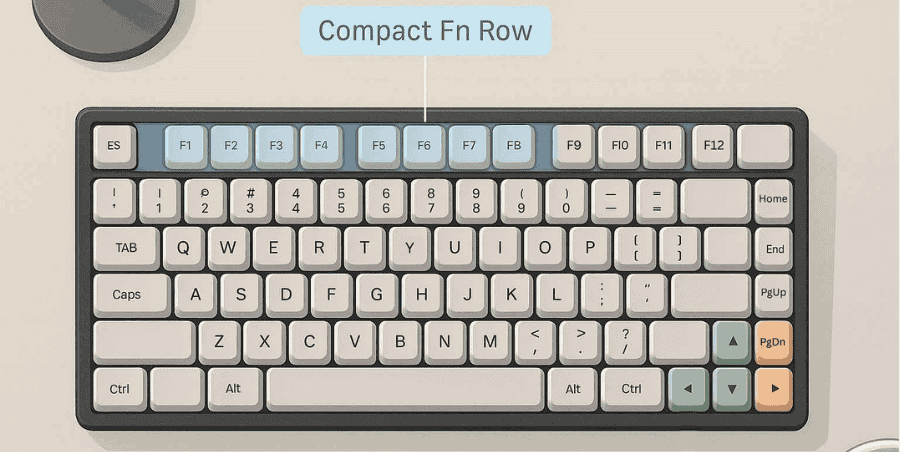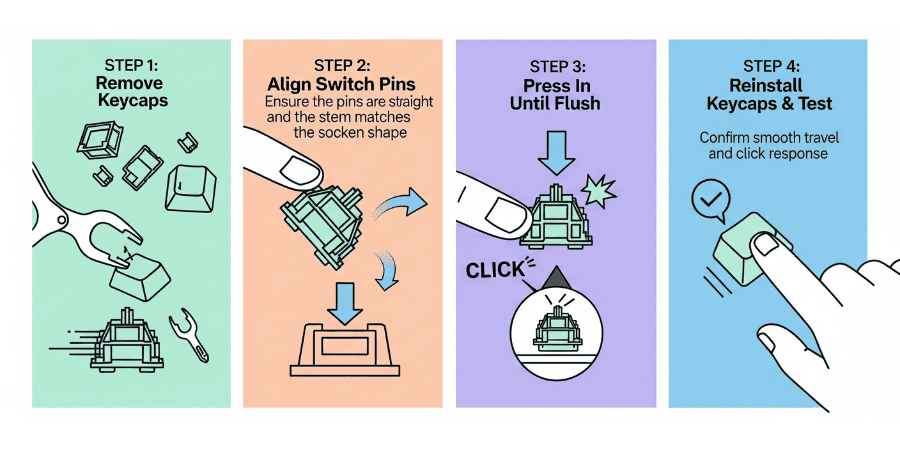The actuation force of a keyboard switch is the amount of pressure you need to press a key before it registers. You’ve probably seen switches online with labels like 40g actuation force, while others may be heavier at 50g or 55g.
This number makes a big difference in your typing experience. Lighter switches (lower actuation force) feel easier and faster to press, while heavier ones can give you more control and reduce accidental key presses. That’s why it’s important to understand actuation force before choosing your switch.
One thing to keep in mind: actuation force and spring weight are not the same. Both are measured in grams, but they describe different parts of the switch feel. So don’t get confused between the two when comparing specs.
Operating force and actuation force
The terms operating force and actuation force often get mixed up, but they’re not the same.
- Actuation force is the amount of pressure needed for a key to register a press. In other words, the moment the switch tells your computer “this key was pressed.”
- Operating force is the pressure required to push the key all the way down until it bottoms out.
For example, you might have a switch with a 45g actuation force, but the operating force could be closer to 55g or more because pressing all the way down takes a bit of extra effort.
Lighter switches
Lighter switches are very popular among gamers because they give a faster response with less effort. A small press is enough to register, which can be the difference between winning or losing in fast-paced games. They also help reduce finger fatigue during long gaming sessions since you don’t need to press as hard.
The downside is that lighter switches may not suit everyone. If you prefer a bit of resistance or want to avoid accidental key presses, heavier switches might feel more reliable. It really comes down to personal preference.
Some well-known examples of lighter switches include:
- Cherry MX Red – smooth and linear, a common pick for gaming.
- Gateron Yellow – slightly heavier than Reds but still very light and fast.
- Kailh Speed Silver – designed for quick inputs with very low actuation force.
These kinds of switches are best if your priority is speed and comfort. But if you like a stronger, more deliberate keypress, you might want to explore medium or heavy switches instead.
Heavier Switches
Heavier switches need more force to register a key press. Because of this, accidental presses are much less common simply brushing or grazing a key won’t activate it. Many people like this extra resistance because it gives a sense of control and precision when typing.
However, there’s a trade-off. Since heavier switches demand more effort, they can cause finger fatigue during long typing or gaming sessions. Taking short breaks can help, but if you type for hours at a time, they might feel tiring.
Examples of heavier switches include:
- Cherry MX Black – a classic linear switch with higher actuation force.
- Zealios V2 (67g or higher) – tactile switches with noticeable resistance.
- Kailh BOX Navy – very heavy clicky switches with a strong, punchy feel.
Heavier switches are a good choice if you prefer deliberate, firm key presses and want to avoid accidental inputs. They’re less about speed and more about stability and control.
FAQ’S
Is 40g actuation force good?
Gamers often prefer switches with a 40g actuation force because it gives a quick response. Switches like Cherry MX Red, Cherry MX Silver, and Gateron Red are popular choices designed to provide this light and fast actuation.
Are 60g switches too heavy?
Switches with a 60g actuation force are not considered heavy. They fall between light and medium. Heavy switches usually start at 70g or 80g.
What are the three types of mechanical switches?
The three types of switches I know are linear, tactile, and clicky. Each one is different. Linear switches press smoothly without a bump or sound. Tactile switches have a small bump when pressed. Clicky switches have both a bump and a loud click.
If you’re curious about how the circuitry beneath those switches works, check out our deep dive on What Are Mechanical Keyboard PCBs?



